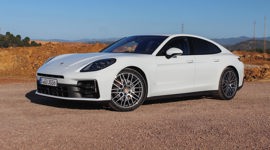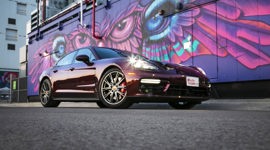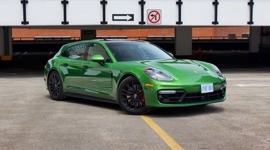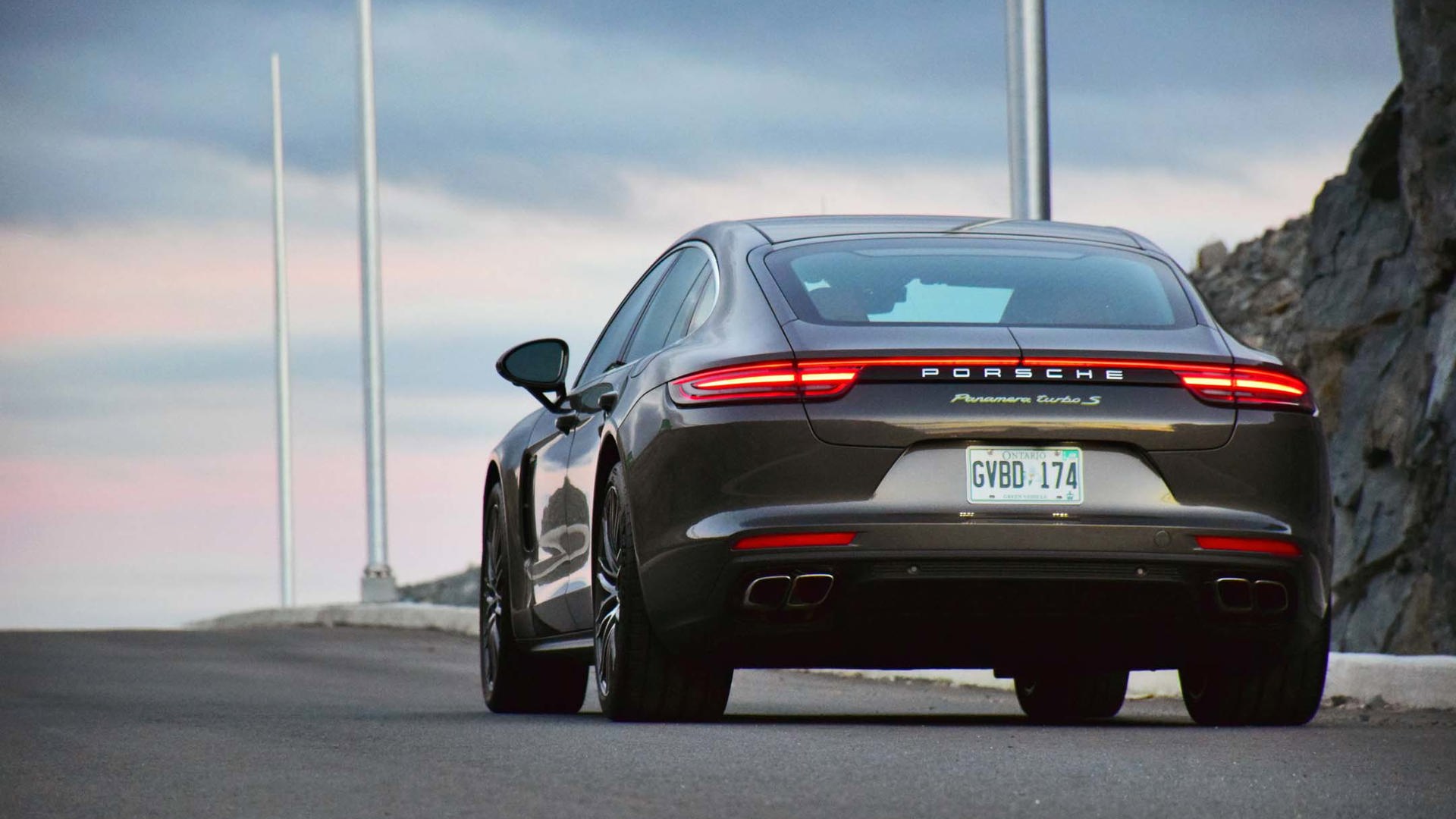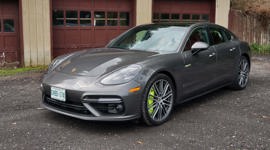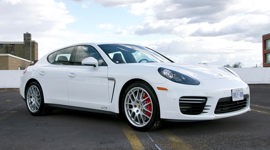Hot on the heels of the launch of the third-generation Porsche Panamera, a trio of new plug-in hybrid (PHEV) models are joining the lineup for the 2025 model year.
Nearly every recent Porsche I’ve driven has been executed at such a high level that didn’t leave much room for improvement; but ever the innovator striving for excellence, Porsche has enhanced its PHEV executive sedan in meaningful ways.
Sharper Style
The latest Panamera’s design hasn’t changed radically, but subtle tweaks add up to a sharper and bolder look. There are more 911 influences throughout, while larger headlights combined with bigger intakes in the front bumper and sharper lines all around make the Panamera look chiselled and sporty. The Panamera has evolved into quite a beautiful sedan with great proportions – a considerable departure from its awkward first generation.
Inside, the Panamera adopts some design cues first seen in the all-electric Taycan, while a touchscreen is now available for the front passenger-side dash. The optional screen is only visible to the passenger and won’t distract the driver. While a little gimmicky, the increasingly common feature is useful for the passenger to find a radio station, input a new destination, or find a charging station without disrupting what’s displayed on the main screen.
The new toggle-style gear selector is also now located to the right of the steering wheel, which opens up space on the centre console. I don’t love the continued use of gloss-black surfaces on the centre console because it attracts so much dust, and the cabin could use more small-item storage, but the interior is executed with Porsche’s trademark obsessive build quality.
More Power, More Range
The Panamera has three PHEV powertrains available, all with standard all-wheel drive (AWD) and an eight-speed automatic dual-clutch transmission. The E-Hybrids are all more powerful, have more range, and charge faster than the previous-generation models.
The Panamera 4 E-Hybrid gets a twin-turbocharged 2.9L V6 paired with a 25.9-kWh battery pack, with a combined system output of 463 hp and 479 lb-ft of torque. The 4S E-Hybrid has the same setup but with a total system output of 563 hp and 553 lb-ft of torque, and more standard features.
The Turbo E-Hybrid pairs the same PHEV system with Porsche’s already bonkers twin-turbocharged 4.0L V8 for a total system output of 670 hp and 686 lb-ft of torque, allowing for a sprint to 100 km/h in a claimed 3.2 seconds with the standard Sport Chrono package. The Turbo is deceiving and looks like a sleeper, but its dramatic electrically-aided acceleration – coupled with the mighty growl and sinister burbling from the eight-cylinder – provides endless entertainment, giving this typically serious sedan some needed personality and brag-worthy performance.
All E-Hybrid models come with an 11-kW onboard charger that should get a full charge in about 2.5 hours using a 240-volt outlet, an improvement over the previous Panamera PHEV models. The gas engines can also be used to charge the battery up to 80 per cent while driving. The battery pack is the same physical size as the previous model but is 45 per cent more energy dense.
Official Canadian fuel economy and range figures weren’t announced at the time of this writing, but Panamera E-Hybrid models should get 50 to 60 km of all-electric range – an improvement over the previous model’s 31 km – which can be used at speeds of up to 140 km/h. The European range rating is about 90 km, but those figures are known for being overly optimistic.
After about 90 minutes of driving, the 4 E-Hybrid, which started the day with a full charge, showed an indicated fuel economy average of just 3.5 L/100 km, while the Turbo showed 11.5 L/100 km later in the day, long after its charge was depleted. That’s not bad for something with as much power as it has.
New High-Tech Suspension
All Panamera E-Hybrid models now get Porsche’s excellent air suspension and adaptive dampers as standard. The previous PHEVs already handled like sport sedans should, but the new setup allows for a more comfortable ride without sacrificing performance. In practice, it works as expected and helps uphold Porsche’s benchmark-setting handling.
Taking it a step further, however, the most significant innovation here is Porsche’s new active ride control system, which is optional on all the E-Hybrid models, replacing the previous generation’s already good anti-roll bars. This high-tech suspension system controls each wheel individually, automatically reacting up to 13 times a second to compensate for changing road conditions and reacting to driving behaviour to neutralize body movement.
The way it works feels almost spooky. You can't feel a thing driving over sewer grates, heaves in the road, or even speed bumps. Suppose there’s a pothole, for example; in that case, the suspension pushes the wheel into the pothole while also raising that corner of the car higher so there’s essentially no body movement, making it feel like the sedan is floating and making it more serene and comfortable in the worst conditions than it has a right to be.
The new active suspension also pays dividends when it comes to performance. It allows the Panamera to lean into a corner like a motorcycle, increasing stability and eliminating body roll. This is a wild innovation, and I’ve never really experienced anything like this outside of a Mercedes-Maybach or Rolls-Royce. This new setup might be even better than the systems on those cars. It takes a lot to upset the Panamera’s ride or handling when equipped with this system, and it’s really cool to feel its body remain totally flat and composed regardless of the situation.
As always, the precise and heavy steering is a highlight, while the optional rear-axle steering helps the Panamera feel smaller and more agile. The long sedan can become a handful in tight alleys and parking garages without the four-wheel steering.
The only other minor hiccup experienced during my drive was a shuddering in the 4 E-Hybrid when taking my foot off the brake pedal and rolling away from a stop, like the dual-clutch transmission was hesitating.

Final Thoughts
It’s always impressive when Porsche can improve on greatness. Bringing its innovative new active ride suspension to the 2025 Porsche Panamera E-Hybrid lineup makes them better at balancing performance and comfort in a unique way. It also makes the PHEVs even more desirable over their strictly gas-powered siblings, because the system isn’t available on those models. With the added enhancements to the hybrid system and a stylish but understated look, the Panamera E-Hybrids are well-rounded and efficient, adding increased comfort to Porsche’s trademark stellar driving dynamics.
2025 Porsche Panamera E-Hybrid Canadian Pricing (before $2,950 destination fee)
- 4 E-Hybrid: $129,800
- 4S E-Hybrid: $148,900
- Turbo E-Hybrid: $223,000


















































